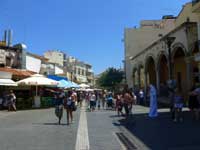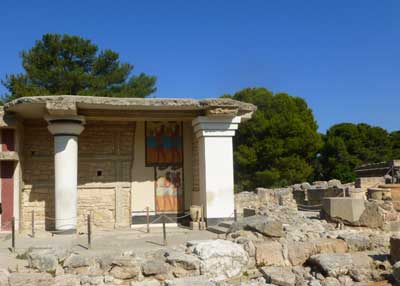Heraklion sights and places to see
.
 For something different, take a ride on one of the little road
trains that run along the sea front or tour further afield. The
trains are styled to look like old-fashioned steam trains, which
is part of their attractiveness. One route that is taken by the
Little Red Train company is the Galatas Country Tour. It drives
through orange groves in the valleys to the south of the main
road, making a brief stop at Ayia Lake to admire the reflection
of the snow-clad mountains reflected in the lake and then on to
the Allied War Memorial. It stops also at the village square at
Galatas to visit the church and the small museum. Such trains
have several advantages. There is no glass in the windows so
photographs can be taken from the moving train without getting
reflections and secondly, as the train has no tracks, it can go
just about anywhere. You don"t even have to walk to the nearest
station if your hotel is on route it will stop and pick you
up.
For something different, take a ride on one of the little road
trains that run along the sea front or tour further afield. The
trains are styled to look like old-fashioned steam trains, which
is part of their attractiveness. One route that is taken by the
Little Red Train company is the Galatas Country Tour. It drives
through orange groves in the valleys to the south of the main
road, making a brief stop at Ayia Lake to admire the reflection
of the snow-clad mountains reflected in the lake and then on to
the Allied War Memorial. It stops also at the village square at
Galatas to visit the church and the small museum. Such trains
have several advantages. There is no glass in the windows so
photographs can be taken from the moving train without getting
reflections and secondly, as the train has no tracks, it can go
just about anywhere. You don"t even have to walk to the nearest
station if your hotel is on route it will stop and pick you
up.
 The suburban areas around the centre of the town are not
significant but, the old city within its walls is still, today,
moving and impressive and is full of shops, public squares,
cafes, bars and restaurants and imposing structures depicting
Heraklion"s long history. , amongst which are a variety of
different buildings from the periods of Venetian and Turkish
occupations. These include the tremendous Venetian castle which
protects the port, the Venetian Loggia, The impressive Byzantine
church of Agios Titus, The Lions Square, (full of young people
both locals and visitors), the cathedral of Agios Minas and the
church of Aghia Ekaterini. There is the Central market which is
lined with shops selling everything you can think of as well as
plenty of taverns and small cafes. For a more romantic setting,
the small port of Megalos Koules is lined with fish taverns
where you can admire the sunset and watch the little fishing
boats coming and going. On a spiritual, intellectual and
artistic level, Heraklion has something for everyone. There are
wonderful churches and cathedrals, museums and exhibitions and
scientific conferences organized throughout the year.
The suburban areas around the centre of the town are not
significant but, the old city within its walls is still, today,
moving and impressive and is full of shops, public squares,
cafes, bars and restaurants and imposing structures depicting
Heraklion"s long history. , amongst which are a variety of
different buildings from the periods of Venetian and Turkish
occupations. These include the tremendous Venetian castle which
protects the port, the Venetian Loggia, The impressive Byzantine
church of Agios Titus, The Lions Square, (full of young people
both locals and visitors), the cathedral of Agios Minas and the
church of Aghia Ekaterini. There is the Central market which is
lined with shops selling everything you can think of as well as
plenty of taverns and small cafes. For a more romantic setting,
the small port of Megalos Koules is lined with fish taverns
where you can admire the sunset and watch the little fishing
boats coming and going. On a spiritual, intellectual and
artistic level, Heraklion has something for everyone. There are
wonderful churches and cathedrals, museums and exhibitions and
scientific conferences organized throughout the year.
There are several Minoan tombs in the areas immediately
surrounding the city. In Gazi, 6km west of Heraklion, for
example, some excellent earthenware statues were excavated and
are thought to depict the main Minoan goddess. All the statues
have their arms raised with other figures escorting them. They
date back to the Minoan era and can now be seen in the
Archaeological Museum of Herakleion.
22km south-east of Heraklion is the medieval monastery of
Agarathus. It is considered to be one of the oldest in Crete. It
is dedicated to the Assumption of the Virgin and was a centre
for education and civilization. Some priests from this monastery
went on to become Patriarchs, for example, Meletius Pegas and
Kyrillus Loukaris. The monastery played a significant role
during the Ottoman Empire as well.
 The Palace of Knossos. The ruins of a Minoan civilization were
purchased and excavated in 1900 by the British archaeologist,
Sir Arthur Evans. It is one of the most important archaeological
sites in Greece. The visitor should allow a full day to visit
the Palace, taking a guidebook and wandering at will whilst
imagining the wealth and power of the legendary ruler, King
Minos.
The Palace of Knossos. The ruins of a Minoan civilization were
purchased and excavated in 1900 by the British archaeologist,
Sir Arthur Evans. It is one of the most important archaeological
sites in Greece. The visitor should allow a full day to visit
the Palace, taking a guidebook and wandering at will whilst
imagining the wealth and power of the legendary ruler, King
Minos.
